Our Family’s Journey of Healing Eczema – Naturally
This blog post shares our personal experience with a natural treatment of eczema. There are many causes and triggers of eczema. If this is something you or a loved one also experiences, consider working with a health coach or naturopathic doctor to find an approach that works for you.
How it Began
When our oldest son, Thomas, was between 2-3 months old, he started to develop a severe, itchy, bumpy, and painful rash all over his head and face. As a first-time parent, I was traumatized. We quickly identified it as eczema and went on to identify causes and treatments.
Initial Dietary Triggers
I first considered potential dietary triggers. When I was pregnant with Thomas, I got severely nauseous every single time I tried to eat oats (my daily breakfast) and I had to avoid oats (and a few other grains such as millet) for the entire pregnancy. After he was born, I happily resumed eating oats – and I was HUNGRY from breastfeeding so I ate a LOT of them. As soon as I eliminated oats from my diet, the severe rash on his face receded.
About a month later, the rash reappeared, but this time on his legs. I wasn’t sure what was causing it. The pediatrician suggested using soaps for eczema and to avoid any and all scents. She also encouraged us to use steroid creams and medications – which I never intend to try (and never did).
For the next two years, we moisturized his eczema daily, avoided bathing too frequently (which seemed to dry it out and make it worse), and avoided ALL grains (except for rice, which seemed to be ok). It was tough at times to eliminate grains, but he definitely experienced flare-ups any time he ate any type of grain.
The BIG Eczema Flare-Up
During the first week January 2022, Thomas’ eczema flared up TERRIBLY. It got worse every single day for several weeks. It was all over both of his legs, with new patches appearing daily. Then his cheeks and face started flushing bright red 1-2 hours after every meal. He was waking up in the middle of the night crying and scratching his legs. There were blood stains on his socks during the day because he scratched them so hard. The only way he could sleep was if I gave him an anti-histamine every day. I was miserably worried, incredibly confused and completely frustrated. What was going on?!?! What was I doing wrong? There had to be something else causing this to all of a sudden spiral out of control.

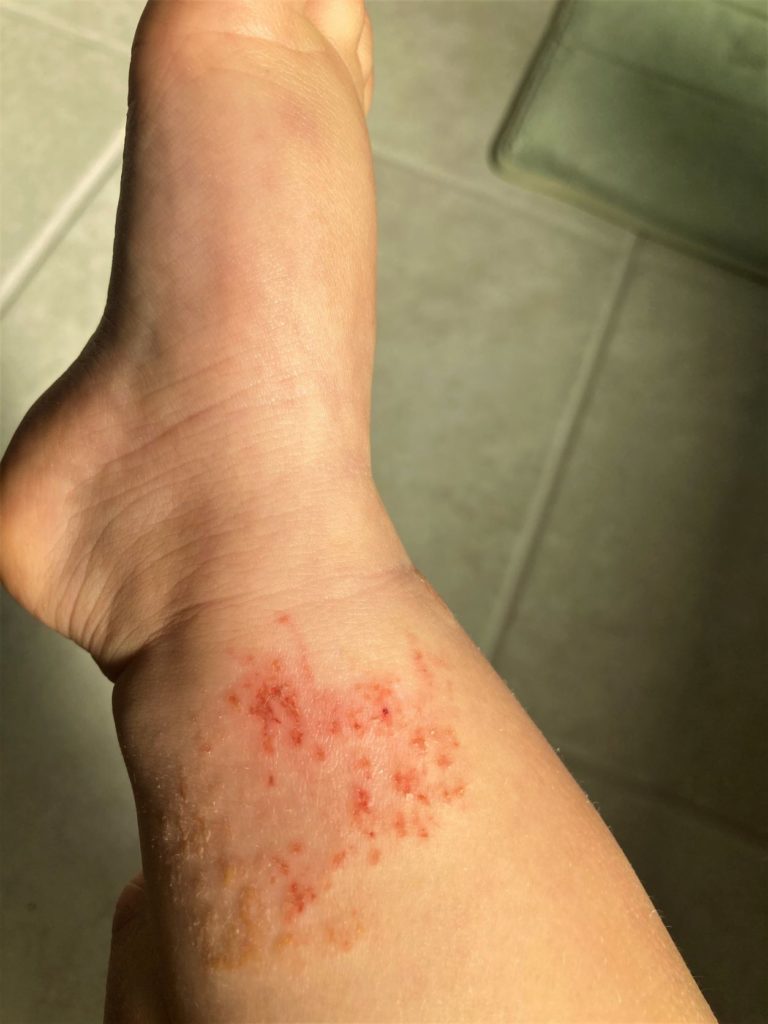
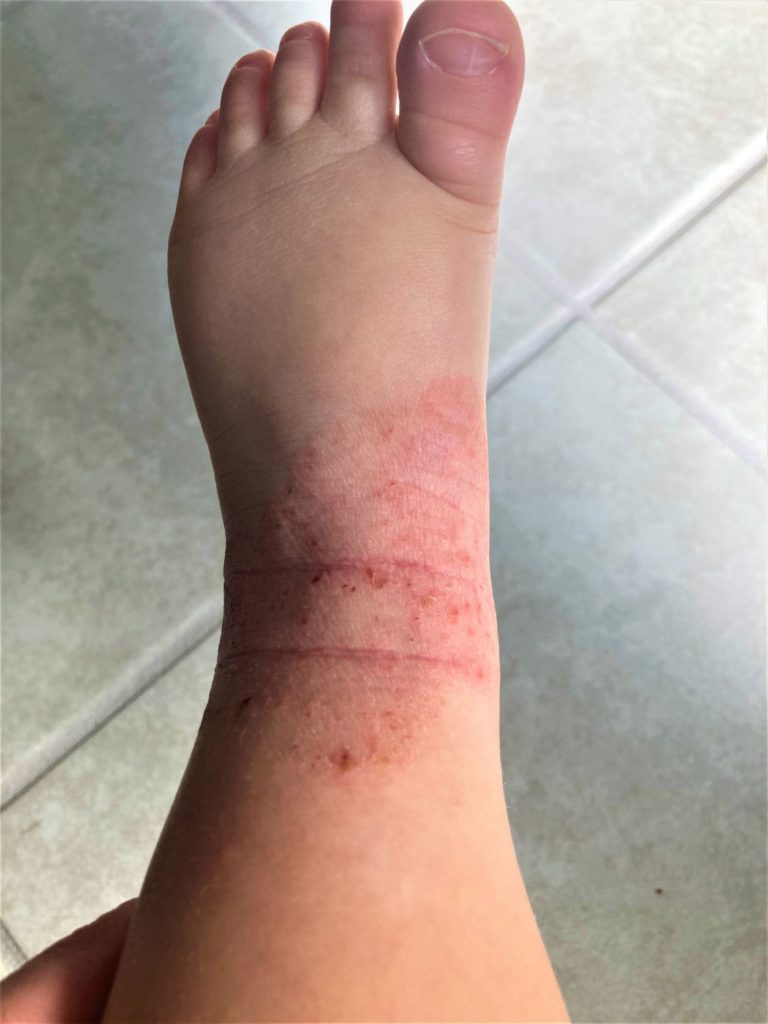
I contacted our naturopathic doctor and she suggested putting him on a low-histamine diet. As I began reading about “histamine,” I was able to put together the many pieces of the puzzle I had been trying to solve for a long time.
The Role and Function of Histamine
Histamine is a chemical that is released by the immune system as part of an allergic response. Histamine release can be triggered by environment (pollen, pet dander, grass), physical activity (running, exercise), stress, underlying medical conditions (viruses, infections), and diet.
When excess histamine circulates throughout the body, it causes a variety of symptoms, including rashes, hives, headaches, digestive discomfort, nausea, fatigue, congestion or sinus issues. In Thomas’ case, it all manifested as eczema.
The “Histamine Bucket” Analogy
Imagine that every person has a bucket for their bodily histamine. Some people’s buckets are smaller, some are larger. The bucket gets filled first by histamine from the environment, stress, physical activity, and health conditions because these are the major fundamental histamine sources.
Histamine is present in many foods, but in less significant amounts as the sources listed above. Dietary histamines are often the final additions to the histamine bucket that causes it to overflow, metaphorically speaking.
There are histamine-containing foods AND histamine-liberating foods. This means that some foods inherently have high amounts of histamine, but other foods cause histamine to be more readily released from the food and circulate in the body. Additionally, as prepared foods/leftovers sit in the refrigerator, they accumulate histamines. Fermented foods (cheese, sauerkraut, wine, beer) have the highest levels of histamines because of the aging process.
A list of the highest-histamine foods is displayed below:
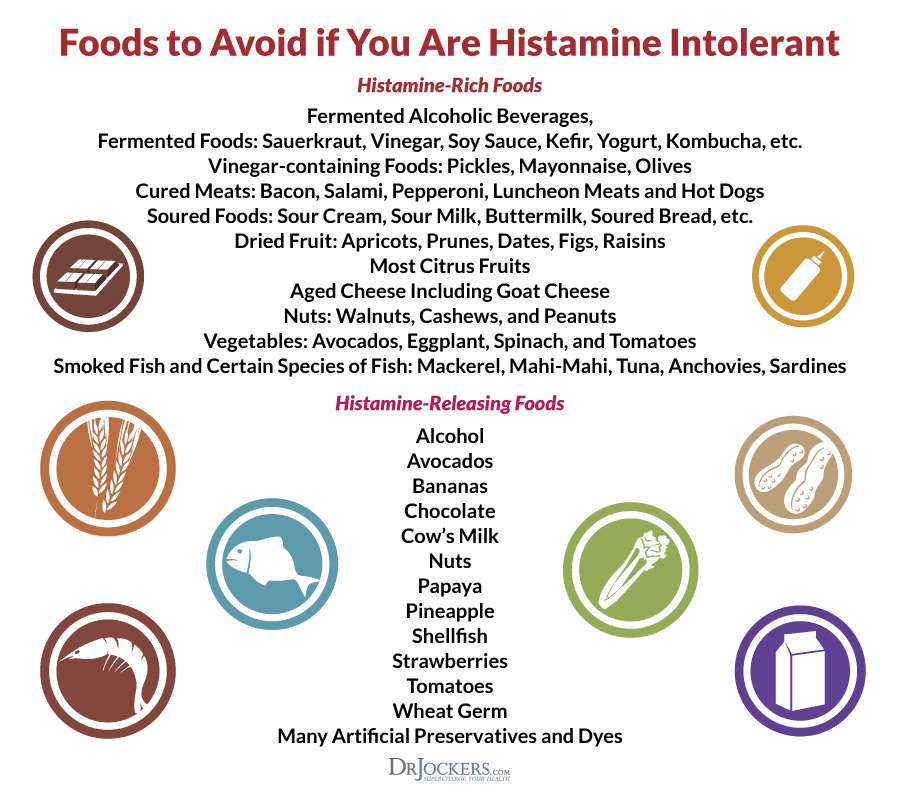
Thomas’ Diet
WELL! After I looked through a few lists of high-histamine and histamine-releasing foods, it was clear that almost every food Thomas ate on a daily basis was involved in the histamine pathway!!!! Yogurt & strawberries at breakfast; eggs, mushrooms, tomatoes, spinach, bananas, cheese, and oranges for lunch, dinner, and snacks every day. (Mushrooms appear on many lists as high-histamine foods.) I read that cinnamon and several spices also act as strong histamine liberators – and Thomas was in a phase of putting cinnamon on EVERYTHING.
Additionally, canned food has exceptionally high levels of histamine – and we were making pumpkin pie with canned pumpkin and salmon burgers with canned salmon.
Thomas’ diet was already limited because he has a severe nut allergy – and already had to avoid grains – so this was incredibly demoralizing. What was left for him to eat??? Even the muffins I make for his snacks were full of spinach, eggs, and histamine foods!
One More Dietary Factor
When food is not chewed properly and undigested food particles enter into the stomach and intestines, they essentially sit there and ferment. As I explained earlier, the fermentation or aging process releases very high levels of histamines. Thomas eats SO fast, and in his mind, when he’s hungry, chewing is optional. (We were constantly encouraging him to chew and slow down.) This was just one more factor that led to his body’s histamine response.
The Road to Recovery
I spent several days reading EVERYTHING I could find about eczema. I wrote out a treatment plan, just like I would for any other health coaching client. We focused on both dietary AND topical approaches.
Topical:
Dead Sea Salts – Soaking in warm bath water and Dead Sea salts is a treatment for many skin conditions, including eczema and psoriasis. We started doing this every other day and initially this is what was most helpful in calming the bad flare-ups. Thomas loved any excuse to play with his bath toys for 15-20 minutes!
Oil-based moisturizers – These help to seal in moisture after soaking in a bath and also throughout the day. We apply Dr. Bronner’s Magic Balm at least 3x each day to every eczema patch. This helps tremendously with the itch and healing.
Dietary:
We eliminated all high-histamine and histamine-releasing foods for 6 weeks. It was incredibly challenging – first, because everything had to be made fresh and not sit in the refrigerator – and second, because how do you tell a 2-year old that he can’t eat his FAVORITE foods for over a month?!?! (As the tears stream down his face because he can’t eat an orange or top his sweet potatoes with cinnamon.)
We explained it all to him in a way he could understand, and all things considered, he did awesome. I had to wrack my brain to come up with new fun and special foods for him – like Quinoa-Zucchini pancakes, Beet-Apple muffins, and Green Pea cookies! My little carnivore also didn’t mind eating ground turkey and ground beef most nights of the week.
Supplements:
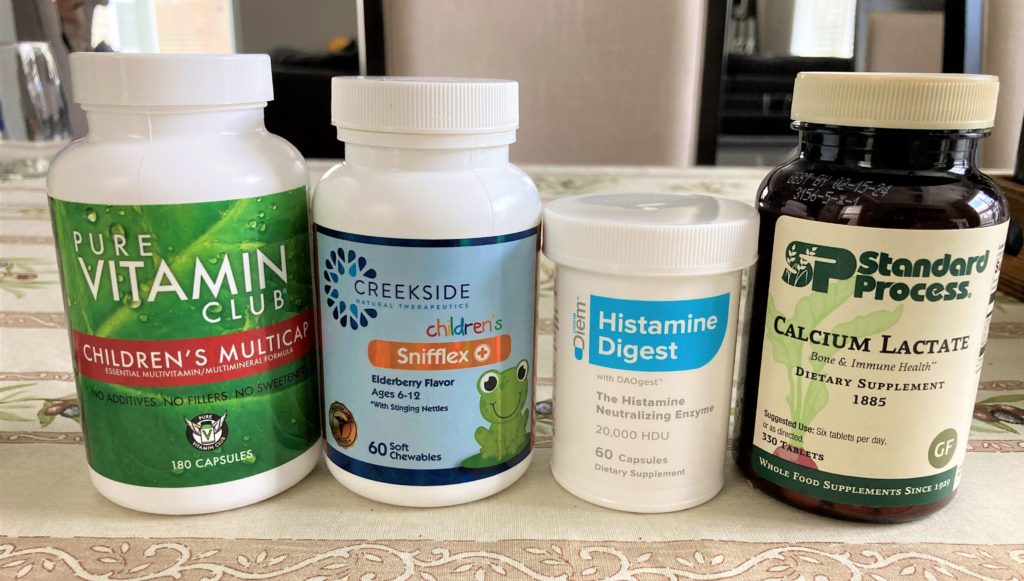
DAO enzymes: Diamine Oxidase is the enzyme that breaks down dietary histamine. (Just like Lactaid supplements break down dietary Lactose) Since it is impossible to avoid all histamine, I gave him these enzymes with every meal to further reduce the amount of histamine his body had to process.
Quercetin, Bromelain, Stinging Nettles, Vitamin C: all of my research endorsed each of these to temper the body’s overactive immune response. I found a children’s supplement that contained all of them and I gave Thomas 1/2 tablet each day.
Multivitamin: since he was on such a limited diet, I felt it was necessary to start supplementing with extra nutrients until he could get them from foods again. Also, there are certain nutrients that are required for the body to produce the Diamine Oxidase (DAO) enzyme naturally and I needed to be sure that he was getting those nutrients so his body could eventually keep up with the histamine-containing foods he was eating.
Calcium: all of his dietary calcium was being eliminated so I gave him a calcium-magnesium supplement to bridge the gap – especially since he’s growing!
Omega 3s: these fatty acids decrease inflammation in the body and the histamine response is an inflammatory pathway.
Genexa Anti-histamine: this is the healthiest and cleanest anti-histamine on the market. Unlike Benadryl, which is loaded with flavors and preservatives, the ingredients are: Diphenhydramine HCl (active ingredient), Organic Agave Syrup, Citrus Extract, and Purified Water. I would highly recommend that any parent invest in a bottle of this for allergic reactions or allergies! Thomas begged for “medicine” every day during the flare-up – because it tasted so good!
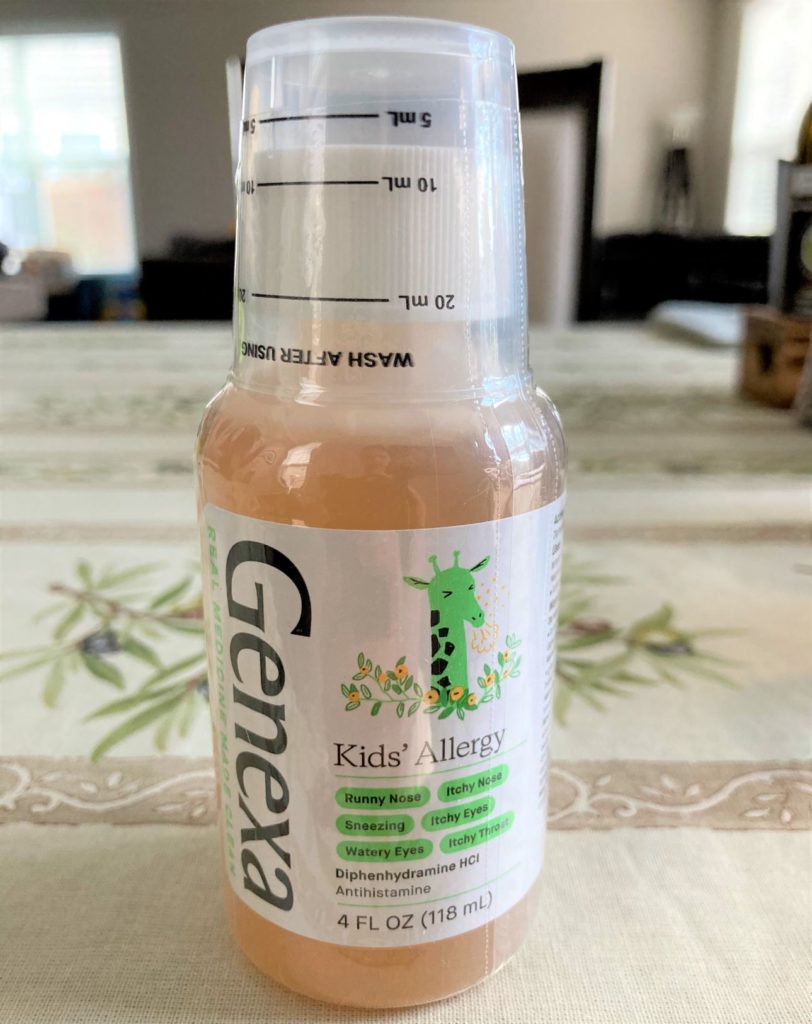
The Big Picture
As I look back and reflect on this experience, I think there were three main causes for the eczema he experienced in the first two years of his life:
- Predisposition to an overactive immune system – some people naturally have a sensitive / overactive immune system, especially people who have Type O blood, (which he has).
- Diet of ALL high-histamine AND histamine-liberating foods – due to Thomas’ other food allergies (unrelated to his eczema) and his picky palate, he was eating a healthy diet, but it was made up of high-histamine foods at every meal, which over time caused a gradual build-up of histamine in his body.
- Inadequate chewing – when Thomas enjoys what he’s eating or when he’s hungry (every meal), he inhales his food. Every time he ate lasagna or eggs, he was so excited, he put the food in his mouth, swallowed it immediately, and then tapped his teeth together a few times to pretend he was chewing. I had been telling him for months he had to chew his food – I can only imagine what was going on in his poor stomach after meals!
It’s GONE!
I am in awe of the healing that took place. Thomas suffered with eczema for two full years of his life. As I am writing this blog post, I can honestly say that it is GONE for the first time since he was 3 months old (he is now 2 years and 3 months old). It has been a heart-wrenching journey, but this chapter is over now. He still has to eat high-histamine foods in moderation for a while, and I’m still giving him the DAO enzymes with most meals to ease the burden on his body, but at least he can eat oranges sometimes and last night he had lasagna for the first time in almost two months!
It’s worth noting that we identified the ROOT CAUSE of the eczema. We didn’t throw steroids on it. We didn’t lather on prescription creams. That’s the beauty of holistic health – we fixed the problem, we didn’t cover it up.
And I almost forgot to mention, the 4 most intense weeks of his major flare-up, my exhaustive research, and intensive cooking from scratch occurred during the last two weeks of my pregnancy and my first two weeks postpartum. Ahhh!!

Before & After Photos
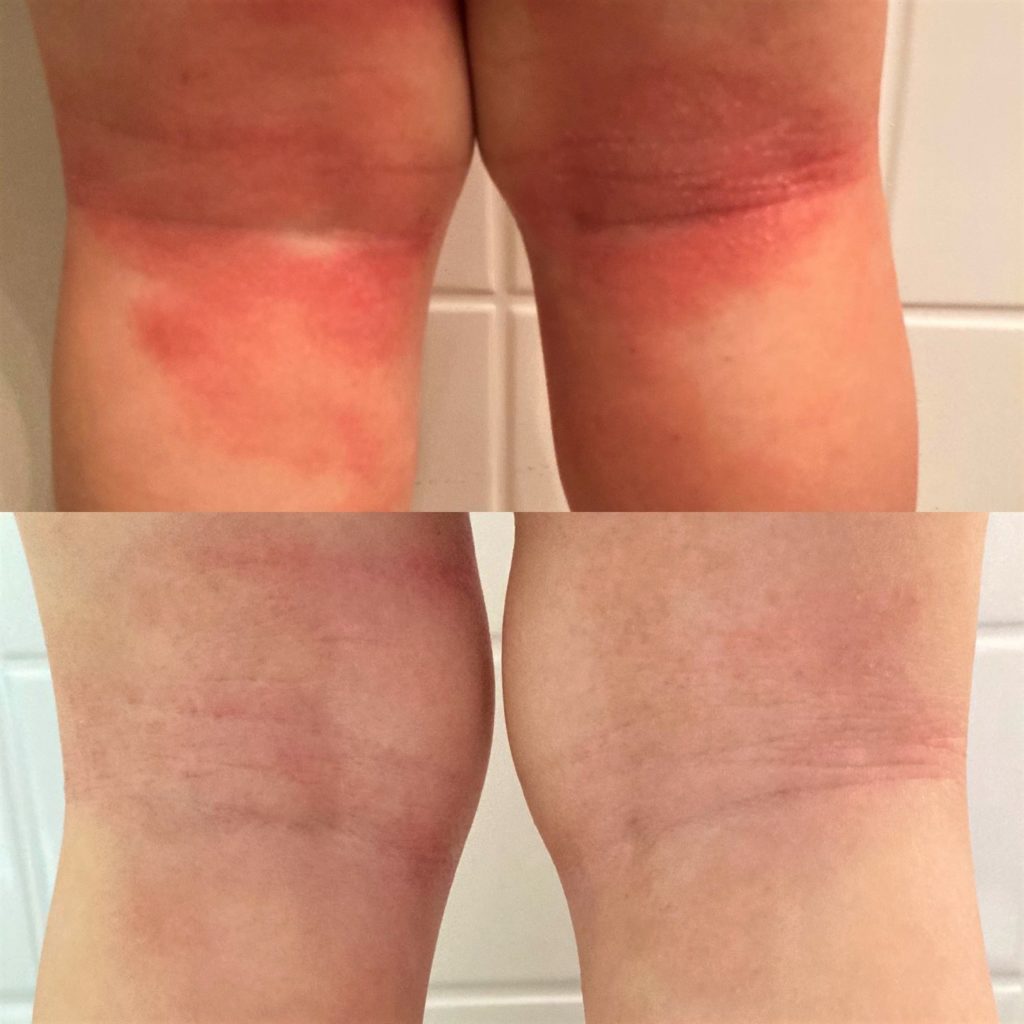


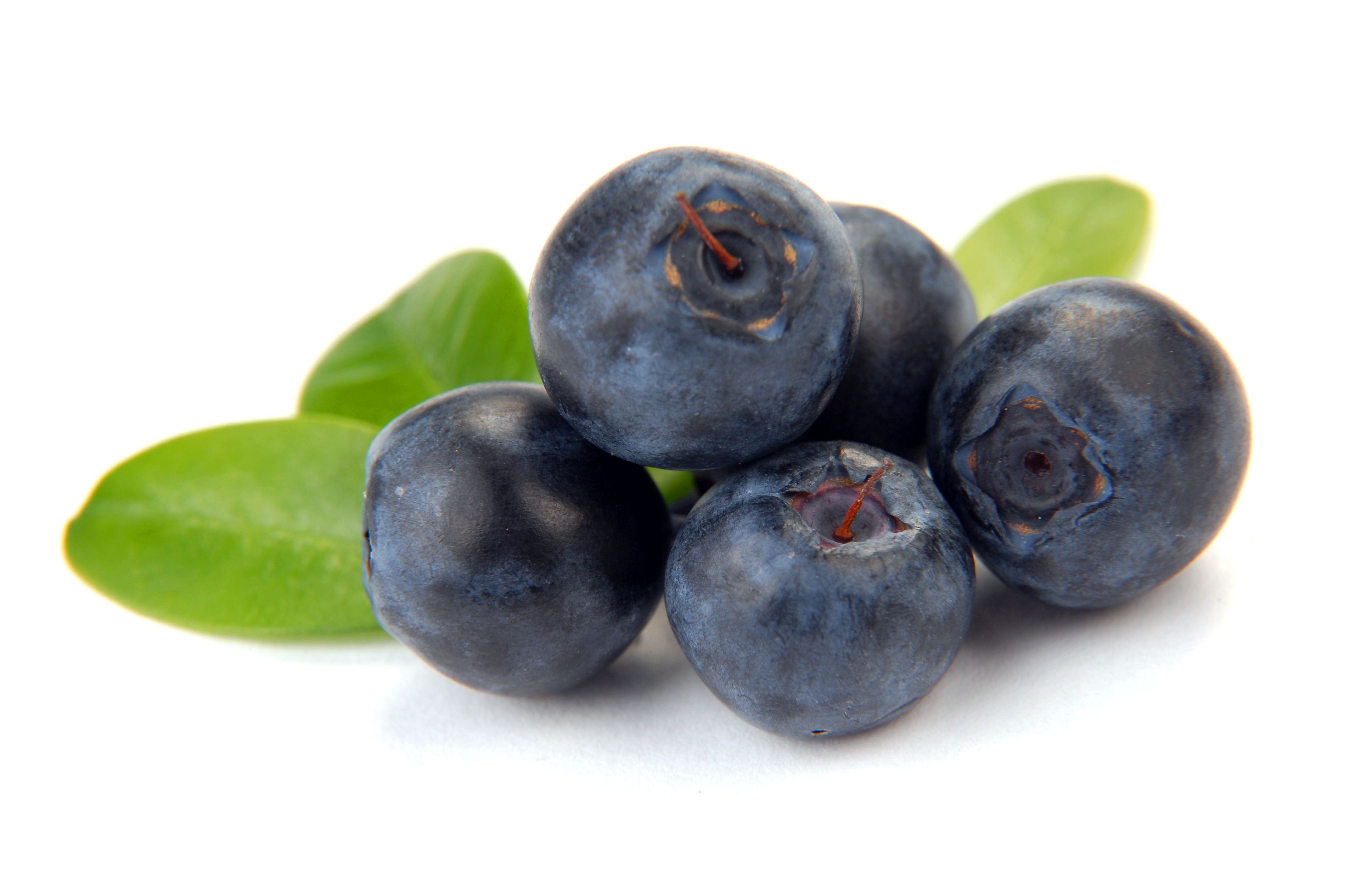
Thomas is blessed that his Mom is this dedicated to discovering the best solutions for his dietary challenges. Thank you Heather for all your efforts to care for all of us!
Thank you!!!! I’m blessed to be in a position to help him with this!!
Wow Heather you are amazing how you figured all that out! I am impressed and am going to get that Genexa to have on hand here when the grandkids come and sometimes have an allergic reaction. Thanks for all the info. Karen McClive
Thank you, Karen!! I’m glad this was helpful to you – and the Genexa is fantastic!
Love this! I randomly started developing eczema patches last January and have been using a steroid cream whenever the flare ups get bad (which is every 2-3 weeks). It’s been awful to deal with. Definitely going to try adjusting my diet and avoiding these foods and hope that helps! Thanks for sharing your and Thomas’ experience!
I’m so glad this was helpful! If that doesn’t seem to do the trick for you, let me know – everyone has different triggers and different things that work but the ones I mention in the post are some of the most common 😉